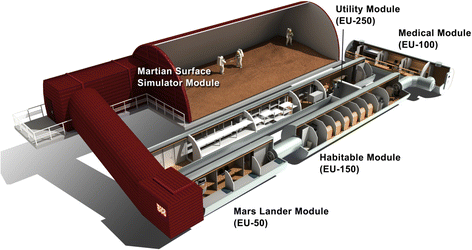Human exploration of planet Mars has a long history with number of robotic missions surveying the Martian surface and environment, including the Viking program (1975), the Mars Exploration Rover Mission (2003), the Phoenix lander (2008), and the Mars Science Laboratory (2012). For the future human space exploration, crewed Mars mission is considered as one of the most important next steps.
It has been assessed that a potential round trip to Mars with a short stay could be carried out in approximately 520 days. Besides various technical issues, one of the major challenges is protection of human crew from illness and infection caused by pathogenic microorganisms.
The Mars500 project was a psychosocial isolation experiment aiming to collect psychological and medical data, and the first full duration simulation of a crewed return flight to Mars. For 520 days, six crew members lived in a confined spacecraft mock-up located in Moscow, Russia. The “MIcrobial ecology of Confined Habitats and humAn health” (MICHA) experiment was carried out to obtain information on the occurring microbiota dynamics, and microbial load and diversity in air and on various surfaces from this unique, isolated habitat.
In the study by Schwendner and colleagues “Preparing for the crewed Mars journey: Microbiota dynamics in the confined Mars500 habitat during simulated Mars flight and landing” published in Microbiome the authors report diverse microbial communities on all surfaces dominated by human associated bacteria, but extreme fluctuation in microbial community structure, diversity and abundance throughout the experiment. The microbial diversity decreased significantly over time, and the most defining factors for the microbial communities were location and time spent in confinement. The crew were the major source for microbes, and areas with more human activity were the hotspots for microbial accumulation. However, the microbial load did not exceed the allowed limits defined for International Space Station in-flight requirements, suggesting that the maintenance was adequate. The authors highlight the importance of maintaining the beneficial and neutral bacteria to sustain a stable and healthy system.
Although numerous important data were retrieved on the microbiota development under simulation conditions, it remains largely unclear, how the microbe-human-surface interplay develops during a real Mars trip, as the astronaut’s immune system is negatively affected by stress and microgravity conditions. In addition, also microorganisms reacted stressed under microgravity and can even develop higher virulence potential, or attack surfaces by formation of biofilms and production of acidic metabolic end products – a problem encountered on space station Mir.
Microbial monitoring and control of the indoor microbiome in such completely sealed environments will be mandatory, for the safety of the crew, and appropriate counter-measures against the diversity loss could be an adaptation of the cleaning regime, or the introduction of beneficial microorganisms, through plants or indoor probiotics.
Link: https://microbiomejournal.biomedcentral.com/articles/10.1186/s40168-017-0345-8
